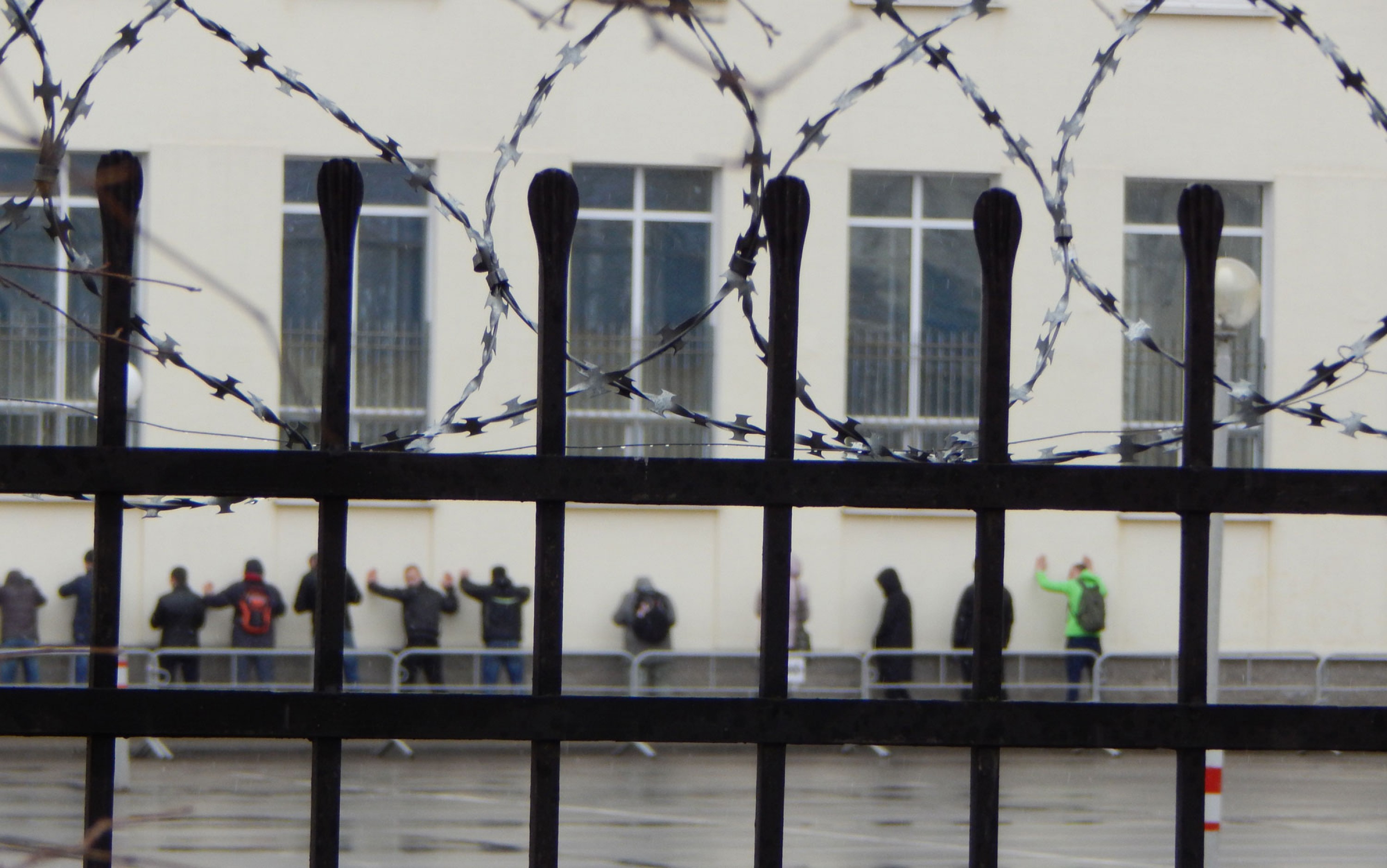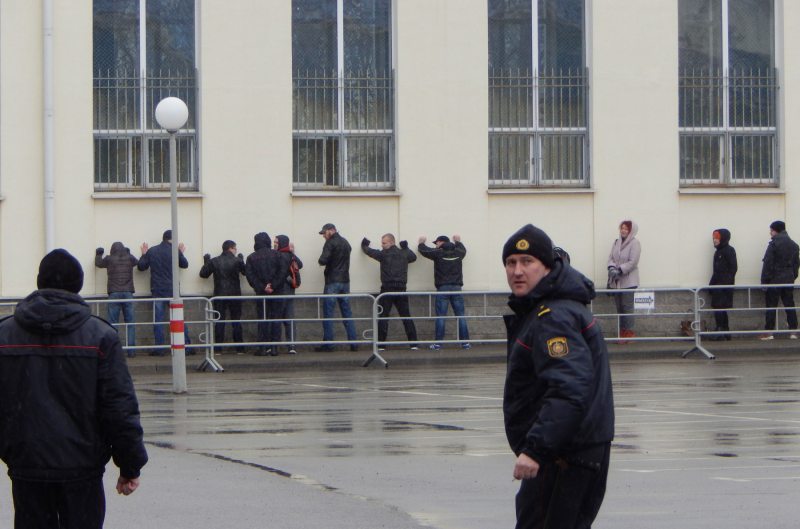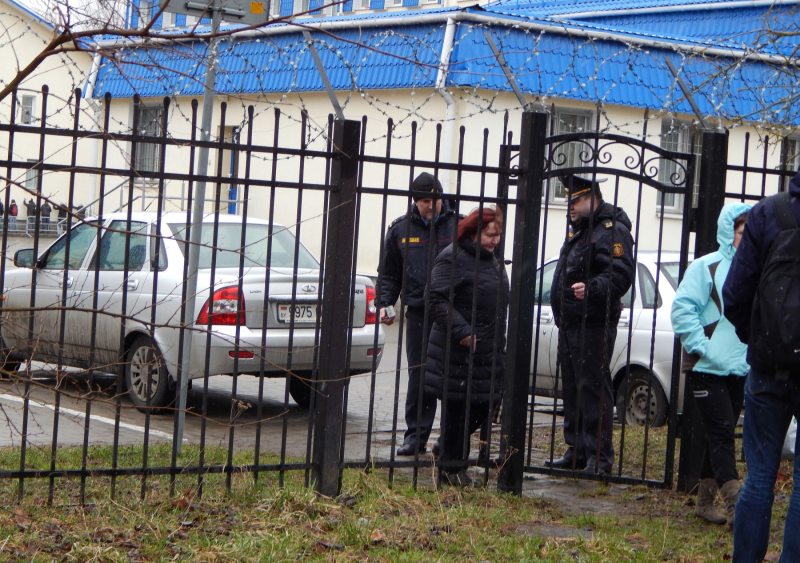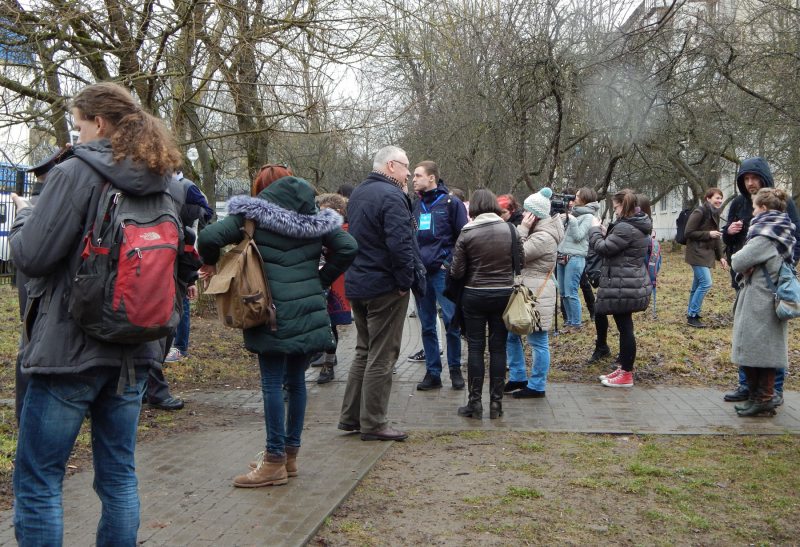Report on monitoring the Freedom Day demonstration in Minsk. 25 March 2017
Observations:
- The march was held at a time when there happened to be mass detentions of participants of public protests, which started mid-February in Belarus, as well as in an atmosphere of fear of possible provocations and mass riots on the march day instigated by the state media;
- In violation of the law “On public gatherings,” the city authorities did not inform the organisers of the march about their decision on the submitted application until March 24, and declined permission to conduct the march on the suggested route in the very last moment;
- Human rights defenders and observers who were planning to conduct civic monitoring of the peaceful gathering on March 25 were preventively detained;
- The participants of the march acted peacefully and without threatening public order. Therefore, there were no justifiable grounds for the violent interruption and detention of those who were going to take part in it;
- Since police officers had forbidden the participants to gather at the stairs of the Academy of Sciences, it was later difficult to distinguish the participants of the march from the ordinary by-standers. Such unprofessional actions by the police resulted in detaining many people who were not participating in the march;
- No less than 700 people were detained during the march, and some of detentions were conducted with a disproportionate use of force. We have also documented several cases of the use of force and poor treatment of citizens by officers of the specialized police forces on the way to the police station and in detention.
Monitoring methodology
The Belarusian Helsinki Committee as well as the Human Rights Center “Viasna” have been conducting systematic monitoring of mass actions for several years using a specially designed monitoring methodology that includes the following aspects: recruiting observers and teaching them the principles of public control, monitoring methodology, and standards of peaceful assemblies; filling in an observation check-list of in presence control; processing questionnaire data and writing a report.
The observation check-lists of mass actions were developed collaboratively by the human rights organisations and include such aspects as scopes for functions of observers and mass media, for organisation and holding mass actions, for police officers, as well as the availability of emergency medical assistance. The observers are allowed to conduct the monitoring only if they endorse the observation rules and principles (independence and political neutrality; description of facts rather than views; non-interference into the observed events; commitments to principles of law; abstention from all forms of violent actions and discriminatory practices, and professional behaviour). While conducting monitoring, observers shall stand apart from protest participants, wear blue and yellow vests, and carry an observer’s badge.
Background
The process of requesting a permission to conduct the march was broadly covered by the media. The first application for the permission to march in commemoration of /the 2017 Day of Freedom/ was made by its organisers on 6 February 2017. The application was dismissed since not all the formal requirements were met. The second application was submitted on 8 February, where organizers requested to allow the march in the following format: participants gather at the Academy of Sciences, march on Independence avenue towards Ianka Kupala park. The Minsk City Executive Committee did not communicate its decision on the application within the time limits set by law (5 days before the event). Instead, on 24 March, the Mayor of Minsk, Mr. Shorts, announced that all the applicants of the gathering withdrew their request for permission to march, therefore any public actions conducted on 25 March 2017 are considered illegal. The Head of the Minsk City Executive Committee pointed out that the organizers declined another march format suggested by the authorities which was the following: people gather at Bangalor square between 12:00 and 12:20 and conduct the meeting until 13:30. The organizers declined this suggestion, which resulted in the recall of the previously submitted application. Thus, there was no permission given by the Minsk City Executive Committee to conduct the march.
The situation in the country before the march was rather strained. Since the beginning of March, mass detentions of participants and organisers of peaceful protests against Presidential Decree № 3 “On prevention of social dependency” have started. By 24 March, almost 300 people were administratively charged and about 100 of them were sentenced to administrative imprisonment.
On 21-22 March, it became known that many citizens were detained due to an investigation initiated into a criminal case under Article 293 Part 3 of the Criminal Code of the Republic of Belarus (on the organisation of public disorder). All the detainees were held in the KGB pretrial facilities or at Minsk Pretrial Detention Centre no. 1. On 23 March, the KGB announced that 26 people were detained in relation to the criminal case.
For the current list of detainees follow the link below.
https://docs.google.com/spreadsheets/d/1yK1JjmNh5Ee1N1nSnw2bNVY2OQy1qQWGVXdFQ8dALaA/htmlview#
Prior to the peaceful assembly on 25 March, it was documented that students and schoolchildren were actively dissuaded from participating in the march.
Monitoring circumstances
It was planned that 40 observers who received the required training and were marked with appropriate identification would conduct on-site continuous observations during the public action on 25 March. The Belarusian Helsinki Committee sent a letter to the Police Directorate of the Minsk City Executive Committee stating that there would be observers during the public gathering who will require appropriate assistance and assured security from the side of the authorities.
At 12:00 on 25 March, a training session for the observers started at the office of the Human Rights Center “Viasna.” An hour into the training, approximately 15 members of the security forces, including officers from the Special Intervention Unit and plainclothes police, entered the room demanding those present put their hands in the air and remain still. All the people present in the office were placed on the floor with their faces down and were forbidden to look at the police officers. The officers provided no explanation for their actions. It was prohibited to use mobile phones and all attempted phone calls were brutally interrupted by police. Altogether there were at least 57 people present in the office, including foreign journalists, French and Russian citizens, and national and international observers.
The officers from the Special Intervention Unit wore uniforms and carried cameras and rubber truncheons. All the actions that took place in the office were video-recorded and photographed. Each person present was forced to declare their full name while filmed. Foreign citizens were taken to another room for personal data collection. The police did not explain any legal grounds for their actions or the further course of events. Finally, all the detainees were taken to the Pieršamajski District Police Department of Minsk.
Upon arrival, all the detainees were escorted to the gym and the police officers conducted a search of their bodies and personal belongings. After the search, personal data such as passport data, addresses, and telephone numbers were collected. At 15:30, all the detainees were released without making a process verbal.
The course of the mass actions
Although all the observers were detained and therefore were prevented from monitoring the march, it was still possible to analyse the course of the events based on the information available from open sources and from live media broadcasts.
Based on the data analysed, it is possible to say the following:
People started gathering at the building of the Academy of Sciences approximately at 13:30. The majority of those present were journalists who had the necessary press cards. Most people who came to the event were immediately detained and placed into police vans.
Since the police abandoned the march, people began gathering along Independence avenue starting from Surganova street and to Doroshevicha street. It was problematic to estimate the exact number of the participants due to the difficulty of distinguishing them from regular by-standers. An estimated number of the participants was 2300 people.
At approximately 14:30, some of the protesters came together at the crossing of Independence Avenue and Piatrus Brouka street. At 15:00, police officers and the military blocked Independence avenue in four places around Darashevicha and Gikala streets and started edging people out of Iakub Kolas square, arbitrarily detaining those present on the street. Each of the ‘cordons’ had about 150 soldiers with large metal shields. People were also detained by plainclothes police, who were not easy to identify as law enforcement officers. For an aerial view of the operation, follow the link below:
https://www.youtube.com/watch?v=o_gxWxqGGwk.
It is worth concluding that the gathering had solely a peaceful nature. Nonetheless the participants have been detained since the very first attempt at gathering next to the Academy of Sciences at 13:30,until the majority of people had moved away from the Academy of Sciences and Independence avenue to Victory square (around 16:00).
700 people were detained in total and brought to various district police stations. Most of them were released within three hours of detention. Up till now, the police have not provided information on the exact number of people detained. Special vehicles, such as police vans, minivans, and buses were used during detentions. Four water jets and cars equipped with loudspeakers were also stationed along Independence avenue.
Recommendations
We call on the police officers to:
Abstain from creating barriers to monitoring peaceful gatherings, as well as to discontinue the practice of preventive detentions of observers;
Stop arbitrary detentions and harassment of participants of peaceful assemblies, as these actions contradict the obligations of the Republic of Belarus under international human rights treaties;
Ensure that policing of mass gatherings is conducted by police officers dressed in uniforms and carrying identification badges or police shields;
Ensure that the employees of the city police’s Information Unit communicate both with journalists and observers.
We call on the Minsk City Executive Committee to:
Observe the law “On public gatherings” in the part regarding the timely notification of the public gathering’s organisers about the decision made on the submitted application;
Abstain from prohibiting the public gatherings under the pretext of not meeting the formal requirements and to act according to the international norm of the usefulness of public gatherings;
We call on policy-makers to:
Initiate legislative change with the goal of bringing the laws of Belarus into compliance with international standards on peaceful assemblies.





















